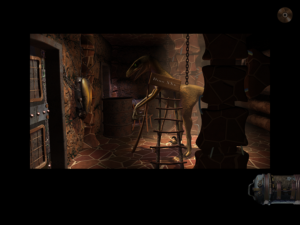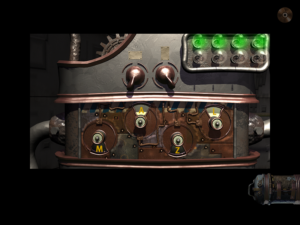Bioscopia: Final Thoughts
 Bioscopia is now off the Stack. I resorted to a walkthough once — I tried to avoid it, out of a suspicion that once I started on the hints, I’d keep on hitting them. A game like this is pretty reliant on the wandering-around-confused phases, because that’s when you notice the hotspots you missed before, and find clues and items you’ll need for puzzles you haven’t encountered yet. But toward the end, when I had more or less exhausted the environment, this rationale wore thin.
Bioscopia is now off the Stack. I resorted to a walkthough once — I tried to avoid it, out of a suspicion that once I started on the hints, I’d keep on hitting them. A game like this is pretty reliant on the wandering-around-confused phases, because that’s when you notice the hotspots you missed before, and find clues and items you’ll need for puzzles you haven’t encountered yet. But toward the end, when I had more or less exhausted the environment, this rationale wore thin.
 There was one point earlier on when I was severely tempted to cheat: it involved four dials, each of which could be set to any of eight letters. A word puzzle? Unlikely in a game translated from a foreign language. The letters conspicuously included A, T, C, and G, the abbreviations of the bases that form DNA, so it seemed reasonable that these would be the four letters in the combination. But in what order? Only one ordering was accepted, it turned out, but if there was a clue about it, I missed it — and having looked at a couple of walkthroughs after the fact, I find that I’m not the only one. But assuming that it’s a permutation of these four elements reduces the solution space from 4096 possibilities to a mere 24, amenable to brute force search. Riven had similarly subjected the player to trying out the remaining possibilities in conditions of incomplete information four years previously, but it somehow seemed more acceptable there. Probably it’s because Riven was aiming for believability, and the occasional lack of pat clues worked into that. Bioscopia is far too fundamentally contrived to ever use realism as an excuse.
There was one point earlier on when I was severely tempted to cheat: it involved four dials, each of which could be set to any of eight letters. A word puzzle? Unlikely in a game translated from a foreign language. The letters conspicuously included A, T, C, and G, the abbreviations of the bases that form DNA, so it seemed reasonable that these would be the four letters in the combination. But in what order? Only one ordering was accepted, it turned out, but if there was a clue about it, I missed it — and having looked at a couple of walkthroughs after the fact, I find that I’m not the only one. But assuming that it’s a permutation of these four elements reduces the solution space from 4096 possibilities to a mere 24, amenable to brute force search. Riven had similarly subjected the player to trying out the remaining possibilities in conditions of incomplete information four years previously, but it somehow seemed more acceptable there. Probably it’s because Riven was aiming for believability, and the occasional lack of pat clues worked into that. Bioscopia is far too fundamentally contrived to ever use realism as an excuse.
The game involves more situational use of biological knowledge than I gave it credit for at first, although it never really gives up on merely using science as inspiration for increasingly-elaborate combination locks. Also, I wondered earlier if the authors were aware of the irony of using robots prominently. It turns out that they are: the robots, it turns out, are the bad guys; the disease that overcame the researchers is caused by their fumes. So it’s kind of a nature-vs-technology plot, except that the whole place is still extremely artifical. There are no living animals to be seen anywhere in the game, which is particularly weird given that there’s an entire section about zoology.
Actually, there’s technically one animal: a human, a fellow explorer, trapped and sick and occasionally sending you text messages stressing the urgency of her situation. Curing and rescuing this damsel in distress produces the ending cutscene, a disappointing and slightly confusing piece of work, with some of the silliest-sounding maniacal laughter I’ve ever heard.
I’ve finished this game a full week ahead of schedule, but that’s OK, because the schedule itself has already slipped by two weeks. So I’ll be proceeding to 2002 without further delay.
 Comments(0)
Comments(0)